The Midwest may be known for its boundless row crops, but these farmers are enlisting the power of trees to prevent flooding and erosion and reintegrate symbiosis between animals and land.

Agroforestry—the integration of trees and shrubs into crop and animal farming systems—has been used since ancient times to produce fruits, nuts, coffee, cocoa and medicinal herbs. Today, new generations of innovative farmers see agroforestry as a solution to not just producing nutrient-dense food and specialty crops but to also mitigate the intensity of climate change-induced weather events.
Meet some Midwestern agrarians, some of whom come from conventional farming families, who are using their land to reestablish the connection between trees, animals, and food production.
Wendy Johnson’s ‘natural savannah’
Wendy Johnson and her husband, Johnny Rafkin, own Jóia Food & Fiber Farm, in Charles City, Iowa. They farm on 130 acres of the land on which her father and grandfather had raised hogs. Johnson felt called back to the land in 2010 after living in California for 18 years. She and Rafkin had a goal of adding diversity and value to her family’s farm through organic agriculture, but they found few organic farmers in the area at the time and none that were implementing agroforestry.
Johnson found support through Practical Farmers of Iowa, a group dedicated to building resilient farms and communities. In 2014, she and Rafkin started transitioning to organic. A small sheep herd that was on the property from when her parents farmed the land was integrated into organic crop rotation. “They were a rough crew of sheep!” Johnson laughs. “They ate grains that couldn’t be sold.”
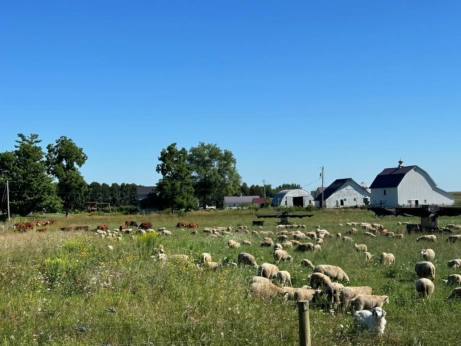
The Joia Food & Fiber Farm farmstead pictured with sheep, sheepdogs, and cattle grazing. (Photos courtesy of Wendy Johnson)
The sheep were getting sick from eating too much grain, so Johnson worked to reestablish a natural savanna, a mixed woodland and grassland ecosystem that had once been prevalent on Iowa’s landscape but was destroyed by grazing and row crops. Her sheep are now grass-fed, healthier and need little medical intervention, she says. Johnson added trees to grazing land to create silvopastures, enhanced existing windbreaks and planted a micro-orchard with fruit and nut trees.
Extreme rain events in 2016 and 2018 stressed field tile drainage systems on her neighboring farms, causing a creek on her property to flood. This motivated Johnson to take further action to mitigate climate change-related weather events. Through assistance from a Savanna Institute agroforestry planner, Johnson added cool-season perennial grasses to the organic crops and riparian buffers along the banks of the creek. She planted native species of hardwoods and softwoods, including willow and poplar. The deep root systems help prevent soil erosion and stormwater runoff.
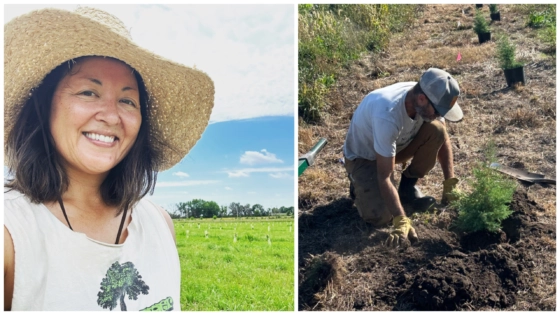
Wendy Johnson (left) in the newly planted silvopasture with nine different varieties of native hardwood trees, many nut-bearing. John Rafkin (right) planting cedars on the farm’s enhanced windbreak project. (Photos courtesy of Wendy Johnson)
To date, Johnson has planted 6,000 trees on 20 acres of their fields, with plans to double the number of trees. She’s optimistic about the future of agroforestry and hopes to see more Farm Bill funding directed toward conservation efforts rather than commodities programs.
She believes agroforestry will attract the next generation of farmers and produce offshoot opportunities such as nurseries to grow tree stock. “Agroforestry has a sense of meaning, a sense of community, and it helps the environment by working with nature. It allows us to be creative again, which I think we’ve lost in agriculture,” she says.
Tucker Gretebeck and Eric Weninger’s flooding fix
Farmers Tucker Gretebeck of All Seasons Farms and Eric Weninger of Embark Maple Energy are neighboring farmers in Wisconsin’s Driftless Area, a unique topographical area covering parts of Wisconsin, Minnesota, Iowa and Illinois. It was never covered by glaciers during the last ice age and thus lacks “drift” of silt, sand and rock. With carved river valleys, forests and cold-water trout streams, the region has attracted nature enthusiasts, foodies and agrotourism.
Gretebeck owns All Seasons Farms with his wife, Becky. They have a dairy herd and grow pumpkins. They offer agrotourism events such as fall wagon tours and pizza on the farm. They’re a member of the Organic Valley cooperative of organic farmers founded in La Farge, Wis. in 1988.
Weninger owns Embark Maple Energy along with his wife, Bree Breckel. They produce maple syrup, along with a line of culinary nutritional energy products called Maple Energy, on 160 acres of predominantly sugar maple trees. Like Gretebeck, Weninger offers farm events, with adventurous and educational themes.
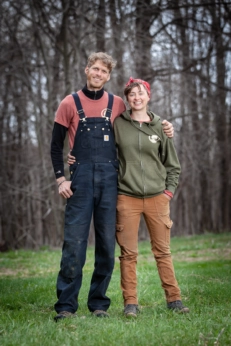
Eric Weninger and Bree Breckel of Embark Maple. (Photo courtesy Eric Weninger)
Both Gretebeck and Weninger view agroforestry as an answer to the dramatic increase in the intensity, duration and frequency of climate change-driven extreme rain events that have caused recurring flooding and, in 2018, the failure of flood protection dams in nearby Coon Creek. Both farmers are board members of the Coon Creek Community Watershed Council (CCCWC), a group that formed in response to the flooding. The waterway is a tributary of the Mississippi River.
The CCCWC plans are still in the works, but Weninger says recommended agricultural practice changes include more tree plantings that can retain water onto the hillsides. The Savanna Institute has been identified as a potential partner due to its past work and research.
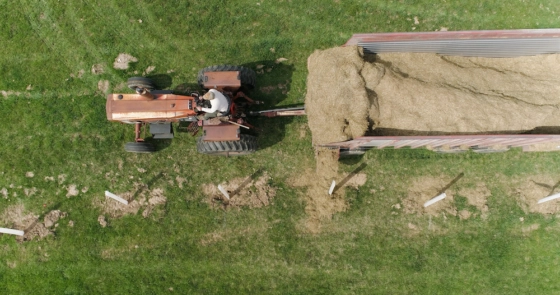
Tucker Gretebeck planting trees on All Season Farm.
“The intense flooding was a driver that influenced me to implement agroforestry,” says Gretebeck. In addition to organic practices including composting and perennial cover crops, he added a silvopasture for his grass-fed cattle. This helps sequester carbon, improves soil and water infiltration, adds comfort for the animals and improves their milk quality.
Gretebeck worked with the Savanna Institute and Bob Micheel of the Natural Resources Conservation Service to help finance the planting of 1,200 trees that included honey locust, black walnut and a poplar hybrid on his property.
[RELATED: Agroforestry Deepens Roots with New Demonstration Farm Network]
Over at Embark, Weninger says he will plant trees such as native oak species and shrubs this spring to filter more water into the ground. “The deep root systems of large trees and shrubs help hold soil in place,” he explains.
Maple syrup could be considered one of the original crops of forest farming. Weninger enjoys working with generations of sugar maple trees, some more than 250 years old. “That reinforces how the activities that you’re doing in a forest can have both generational and real-time impacts.”
He adds that the indigenous Ho-Chunk Nation was among the first to go into these forests to harvest maple sap. “We really learned from their traditions and are continuing something that’s been done for millennia. That time component adds a lot of depth working in and with the forest.”
Wil Crombie’s forested fowl
Filmmaker, photographer and farmer Wil Crombie, along with his wife, Carly, and sister-in-law, Corrissa Peterson, own and operate Organic Compound, near Northfield, Minn, where they raise Freedom Ranger broiler chickens. Their farm is located on the homestead where Crombie was raised. His mother’s family were dairy farmers, and the land had consisted of pasture and row crop fields.
“We’re lucky to have experienced generational changes. The approaches that my grandfather took to manage the land, and the way my parents turned a portion of it into a homestead, allowed me to watch it go from pasture to forest,” says Crombie. “My generation is removing invasive plants and using agroforestry to bring the pasture back as silvopasture.”
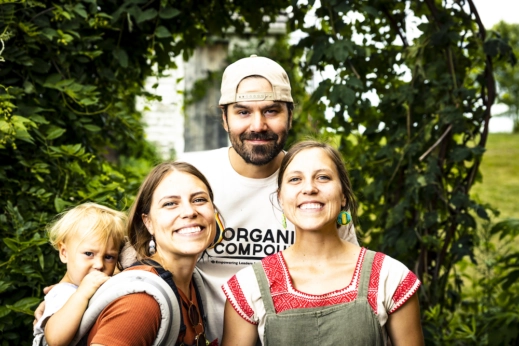
It’s a family affair: Wil and Carly Crombie (middle, right) with sister-in-law Corrissa Peterson (left). (Photo courtesy of Wil Crombie)
Starting in 2014, Crombie transitioned 40 acres of row crop land on his 60-acre parcel. His mentor, Reginaldo Haslett-Marroquin, owns Salvatierra Farms. Together, they formed Tree-Range Farms, a brand of meat chickens raised on silvopasture.
In 2016, Crombie, his wife and Peterson planted 20,000 hazelnut trees for their silvopastures and additional acreage. They added oak, sugar maple, basswood, lilac and elderberry and established alley crops of asparagus, along with a windbreak and a riparian buffer along a waterway.
The farming trio chose hazelnuts and elderberries upon recommendation from elders in their area, and by Crombie’s mentors, Mark Shepard and Terry Durham. “We’re fortunate to have these people helping to facilitate this large-scale regenerative agriculture transition towards agroforestry,” says Crombie.
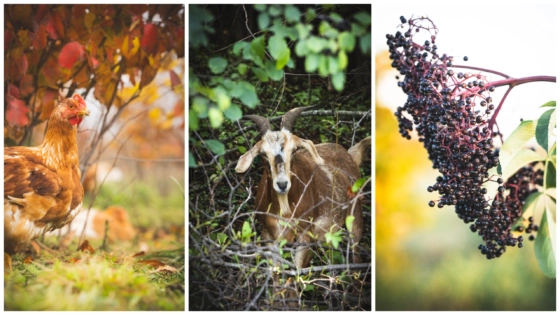
Chicken, originally jungle fowl, thrive in forested environments. Elderberry, becoming popular as a hedgerow crop, provides both farm income and ecological benefits. (Photos courtesy of Wil Crombie)
Manure from the fowl helps fertilize the silvopastures and fields, and the chickens help with pest control by eating insects and grubs. “It’s a symbiotic relationship, and they benefit from shade and protection from the trees—they’re originally jungle fowl, so they deserve to be in a forested environment,” says Crombie.
Crombie is optimistic that agroforestry will go a long way in restoring land but also rural communities. “Agroforestry has the potential to get more people active and into nature,” he says. “Agroforestry is family farming, and agriculture is a family and community-based, hands-on activity. It’s an exciting opportunity to revive our rural communities.”
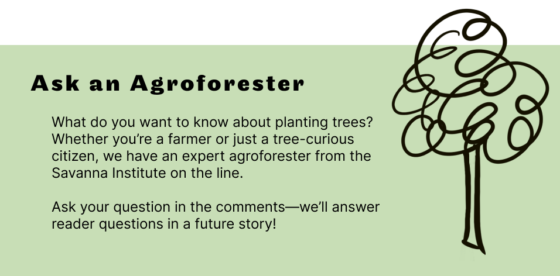
While I do not have much land, [I’m a hobby farmer] I praise the work of these real farmers. I have a number of trees, some chicken, elderberries, chokeberries, sunchokes and a lot of apple trees. I think the future of good farming is a mix of forests and pastures.
I love this life. Agroforestry seems like a promising approach for the Midwest: It offers a range of environmental, ecological, and economic benefits, while potentially addressing climate change concerns.